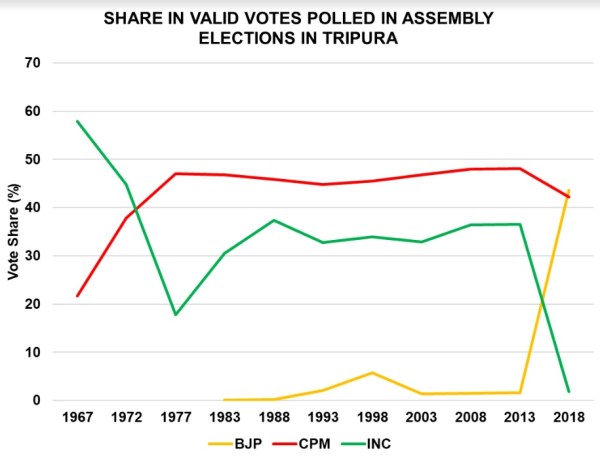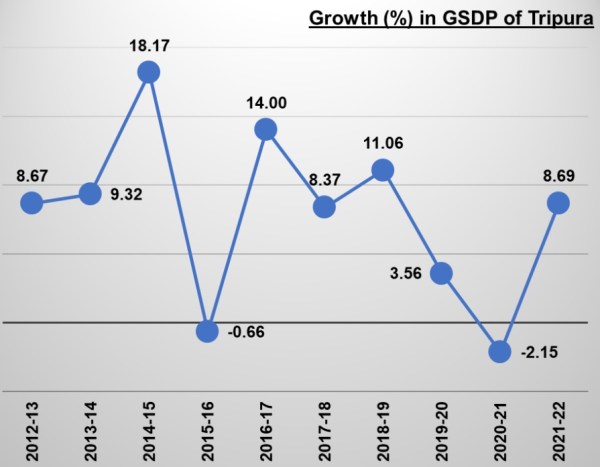For Opposition parties CPI(M) and Congress, the Assembly elections will be a litmus test for their alliance and their future in a state they once dominated. For the BJP, the challenge will be to build on its gains from five years ago.
A look at the electoral data provides a clear picture of how the political topography has changed in Tripura over the decades. In all, nine Assembly elections are set to take place this year in the run-up to the all-important parliamentary polls in 2024.
Seats and vote shares

The Congress was the numero uno in state politics even before Tripura attained full statehood in January 1972. When the polls were held for the Union Territory of Tripura in 1967, the Congress won 27 of the 30 seats. The party won the 1972 Assembly elections too in a landslide, bagging 41 of 60 constituencies.
This is where the Congress story in Tripura starts to decline. The 1972 election proved to be the party’s best-ever performance and five years later, in an election held in the post-Emergency era, the CPI(M) decimated the grand old party, which drew a blank. There was a brief period of resurgence in 1988, which saw the party return to power in coalition with the Tripura Upajati Juba Samiti (TUJS). But since then, it has been all downhill for the party that has seen its electoral base erode. In the last Assembly election in 2018, the Congress drew a blank and its vote share declined to 1.79 per cent, the lowest in all the Assembly elections in the state since 1967.
The CPI(M), which replaced the Congress and ruled the state for 35 years, saw its tally fall from 49 in 2013 to 16 five years later. Its vote share too declined from its highest level of 48.11 per cent in 2013 to 42.22 per cent in 2018.

Meanwhile, the BJP made its debut in the state in 1983 by contesting only four seats. It fielded its candidates, including a woman, in Pramodenagar, Kurti, Dharmanagar, and Jubarajnagar constituencies. But, the party drew a blank and all four of its candidates forfeited their deposits. The party got only 578 votes. From 1983 to 2013, BJP failed to win a single seat in the Tripura Assembly elections. Its vote share also remained under two per cent, except in the 1993 (2.02 per cent) and 1998 (5.78 per cent) elections.
But things changed in 2018 as the BJP’s vote share jumped to 43.59 per cent and it ended Left rule by bagging 36 constituencies. In the last five years, the BJP has consolidated its position. In the 2019 Lok Sabha elections, BJP won both parliamentary constituencies in the state and came first in 51 of the 60 Assembly segments. In the remaining nine Assembly segments, the Congress came first. These seats were Ramchandraghat, Kailashahar, Mandai Bazar, Asharambari, Boxanagar, Karmachara, Takarjala, Simna, and Ampinagar. Six of these Assembly segments are tribal seats. The Left parties continued their dismal run and failed to make a comeback.
Despite the party going from strength to strength in the state, the BJP changed its chief minister last year, replacing Biplab Kumar Deb with Manik Saha.
State economy

Tripura, with an area of 10,491.69 sq km and an estimated population of 40 lakh, is the third smallest state in the country. It is surrounded by Bangladesh from three directions. The state shares over one-fifth of India’s border with Bangladesh. Out of India’s 4,096.7-km border with Bangladesh, Tripura shares about 856 km, which is the highest after West Bengal (about 2,200 km). Tripura shares a bigger border with Bangladesh (856 km) than its two neighbouring states combined — Mizoram (109 km) and Assam (53 km).
The state’s economy is mainly based on agriculture and allied activities, with about half of its population dependent on it. Tripura’s Gross State Domestic Product (GSDP) stood at Rs 40,480 crore in 2021-’22. The four-year period from 2018-’19 to 2021-22 saw lower GSDP growth as compared to the preceding four-year period (2014-’15 to 2017-’18).
One of the reasons for lower growth in recent years is the impact of the Covid-19 pandemic. The state recorded a 2.15 per cent contraction in GSDP in 2020-21. However, Ministry of Statistics and Programme Implementation data shows that the state’s economy started slowing down even before the pandemic began in 2020. For instance, the state registered a growth of only 3.56 per cent in 2019-’20, which was lower than 11.03 per cent in 2018-’19. However, the state’s economy has now shown signs of recovery as its GSDP increased by 8.69 per cent during the 2021-’23 period. The GSDP has crossed the pre-pandemic level. The GSDP figures for 2022-’23 are not available.
Between 2014 and 2018, the state recorded double-digit growth on two occasions — in 2014-’15 (18.17 per cent) and 2016-’17 (14 per cent). However, the GSDP also saw a contraction of 0.66 per cent in 2015-’16.
The per capita income measured as “per capita net state domestic product at constant prices (base year 2011-12)” has followed the same path as the GSDP. The per capita income has registered a slower growth in the last four years than in the preceding four-year period.










